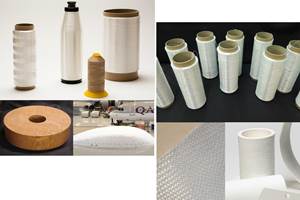SRI advances CMC for solar, renewable energy and industry
U.S. research institute advances “infiltration-free” process for improved performance, durability and affordability of materials able to withstand highly corrosive environments at temperatures beyond 700°C.
Founded in 1946 as the Stanford Research Institute, SRI (Menlo Park, Calif., U.S.) is an independent nonprofit scientific and R&D organization with offices across the U.S. and in Japan. It has pursued research in ceramic matrix composites (CMC) for decades and is part of a U.S. Department of Energy project to improve CMC for solar energy and energy storage applications.
Senior researcher, Junhua Wei, and his colleagues at SRI are advancing CMC to withstand the extreme temperatures and corrosive environments of concentrated solar plants that harness immense heat to store energy in molten salt. Their work promises to enhance the efficiency and sustainability of such solar energy systems and also possibly enable recovery and reuse of waste heat in energy-intensive processes like steel manufacturing.
“Traditional metals like steel fail under the harsh conditions of these [solar] plants, necessitating the development of more resilient materials,” says Wei. “SRI composites stand out due to a technique that integrates the ceramic matrix by chemically linking ceramic particles within the ceramic precursor. This is crucial in preventing cracking, a common failure point, ultimately extending the material's lifespan and reliability.”
SRI’s advanced CMC will improve the performance, durability and cost-effectiveness of concentrated solar plants, contributing to a more sustainable and efficient solar energy system. This in turn helps reduce the environmental impact of energy production and promotes the use of renewable energy sources.
Traditional CMC typically incorporate carbon fibers or silicon carbide fibers for toughness, integrated within a ceramic matrix. The novel method developed by SRI chemically links ceramic particles, dispersed in the precursor resin/polymer, to these strengthening fibers. This helps the resulting CMC resist crack and void formation as the precursor is processed into a ceramic matrix. This enables skipping the time-consuming and costly ceramic infiltration process (e.g., liquid silicon infiltration or melt infiltration) typically used to heal cracks and voids that form during thermal processing of the CMC.
A promising application of these advanced CMC is in solar plants that concentrate sunlight to heat molten salt, which then stores energy. The challenge lies in the molten salt’s corrosive nature and high temperatures required — the process becomes more efficient above 700°C — which degrades traditional containment materials over time.
SRI’s proprietary processes not only offer CMC with increased durability and resistance to this type of corrosion, but also reduced costs. It reportedly can reduce manufacturing costs by 50%. In addition, continuous fibers may be replaced with short, modifying carbon fibers to deliver further cost reduction. The process is also said to improve the CMC’s mechanical performance. SRI is producing CMC that maximize the composite architecture and focusing on process development to create a sensor-embedded system for feeding data into digital twins.
The resulting CMC, with a high-concentration of ~20% ceramic particles (by volume), provides the properties to suit additional applications such as ablation-resistant thermal protection systems (TPS) in hypersonic vehicles, heat exchangers with high thermal conductivity for industrial de-carbonization units and first wall structural materials for nuclear fusion applications.
SRI’s developments represent a significant step forward in material science, says Wei. “By enhancing the strength and longevity of the materials used in concentrated solar plants, SRI can improve the efficiency and sustainability of renewable energy sources. This innovation underscores the importance of robust materials in extreme conditions, paving the way for more reliable and cost-effective renewable energy solutions.”
Related Content
ORNL, Sierra Space create novel C/SiC TPS for reusable space vehicles
CMC tiles will be used on the Sierra Space DC100 Dream Chaser spaceplane carrying critical supplies and science experiments to and from NASA’s ISS.
Read MoreDITF Denkendorf advances sustainable carbon fibers, oxide fibers for CMC and more
The German Institutes of Textile and Fiber Research are targeting more sustainable carbon fiber via low-pressure stabilization and bio-based precursors, and working with Saint-Gobain to commercialize oxide ceramic fibers for CMC.
Read MoreDeveloping milling for CMC because grinding takes too long
Economical processes that can cut machining time by 70% are being tested on aeroengine turbine blade demonstrators by Hufschmied and DLR in the SCANCUT project.
Read MoreThe future of quartz and oxide fibers at Saint-Gobain Advanced Ceramic Composites
New business builds on 100-year legacy in quartz, prepares for growth, while starting production of oxide fibers to meet increased demand for CMC by aerospace and industrial sectors.
Read MoreRead Next
Black Hawk program receives improved turbine engine with CMC
GE Aerospace T901 flight test engines will replace GE T700 for the UH-60M Black Hawk helicopter, using additive manufacturing and ceramic matrix composites (CMC) for 1,000 shaft horsepower increase.
Read MoreGeneral Atomics wins DOE contract to develop silicon carbide CMC for fusion power plants
GA-EMS will leverage experience with SiGA SiC/SiC cladding for nuclear fuel rods to develop new SiC composite foam and other materials for fission and magnetic fusion programs.
Read More“Structured air” TPS safeguards composite structures
Powered by an 85% air/15% pure polyimide aerogel, Blueshift’s novel material system protects structures during transient thermal events from -200°C to beyond 2400°C for rockets, battery boxes and more.
Read More


























